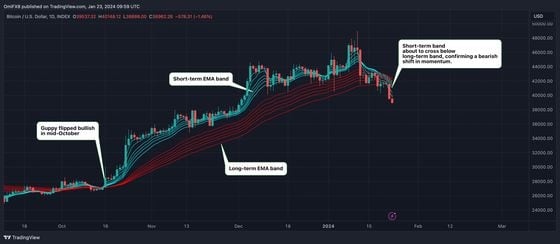
10 Years of Decentralizing the Future
May 29-31, 2024 – Austin, TexasThe biggest and most established global hub for everything crypto, blockchain and Web3.Register Now
A technical analysis indicator that flipped bullish mid-October, kicking off bitcoin’s multi-week price surge of 70%, is about to flash a bearish signal to trend-following traders.
Developed by Australian trader Daryl Guppy, the Guppy Multiple Moving Average indicator groups several exponential moving averages (EMA) into two categories, short and long-term, to help traders identify trend changes and trade a trending market. The short-term band, represented by green lines, comprises 3-, 5-, 8-, 10-, 12-, and 15-day EMAs, and the long-term band, identified by the red color, comprises 30-, 35-, 40-, 45-, 50-, and 60-day EMAs.
A bearish-to-bullish trend change occurs when the green band crosses above the red band. A bearish shift in momentum occurs when the green band crosses below the red band. Most traders tend to be trend-following, preferring to enter when the crossover appears and hold in the direction of the long-term trend.
At press time, the GMMA looked set to produce a bearish crossover, with the green band nearly moving below the red band. In other words, the indicator is signaling growing bearish momentum.

Bitcoin traded well below the red band at press time, changing hands at $39,200 on major exchanges.
The green band crossed above the red band in mid-October, when bitcoin traded near $28,000, signaling a bullish trend ahead. The cryptocurrency consistently rallied in the subsequent weeks, consistently trading above the red band to reach a high of nearly $49,000 on Jan. 11.
Previous bull crosses dated mid-January and mid-March 2023 led to multi-week bullish trends. Similarly, bear crosses of December 2021 and April 2020 brought prolonged pain to the market.






